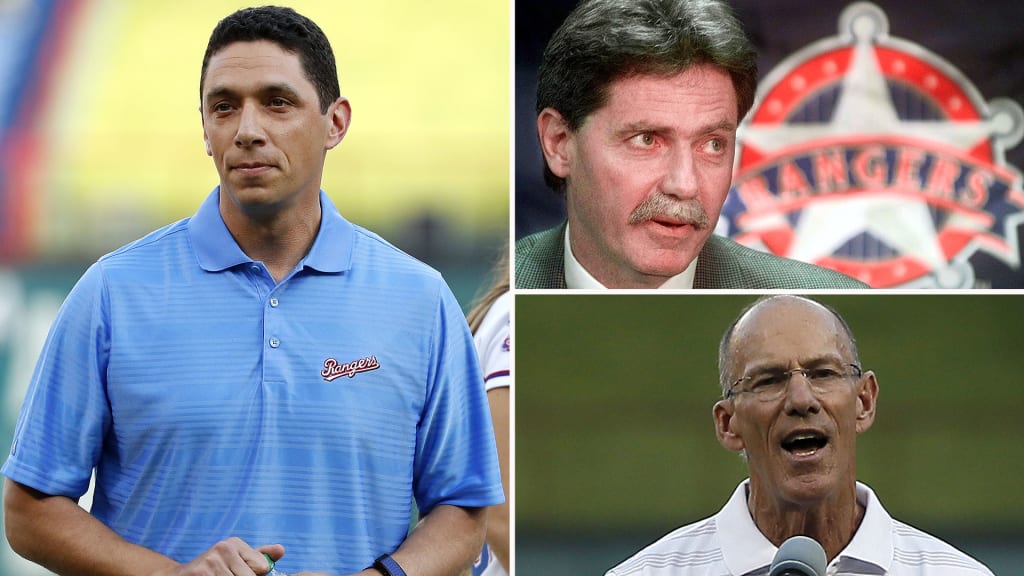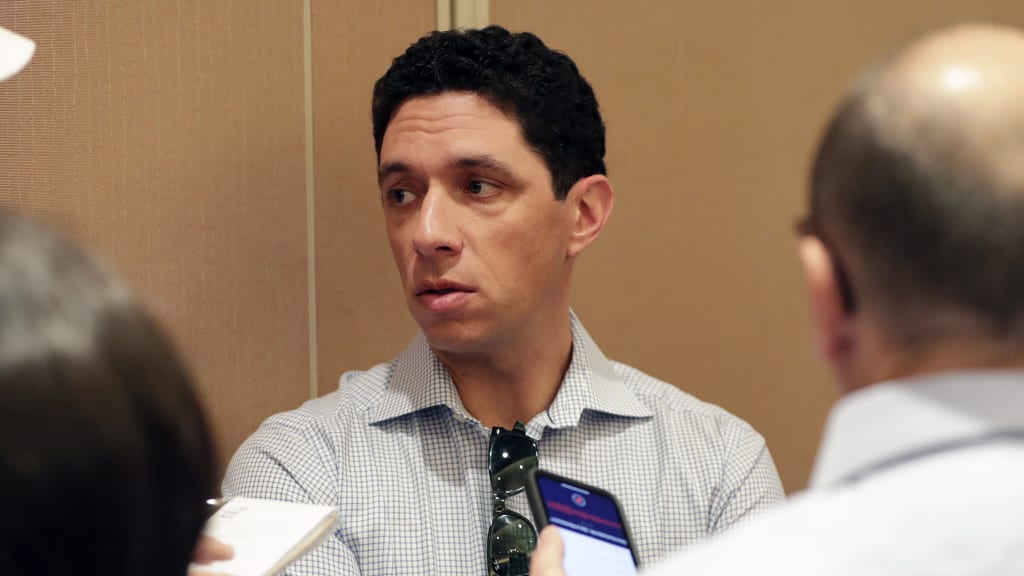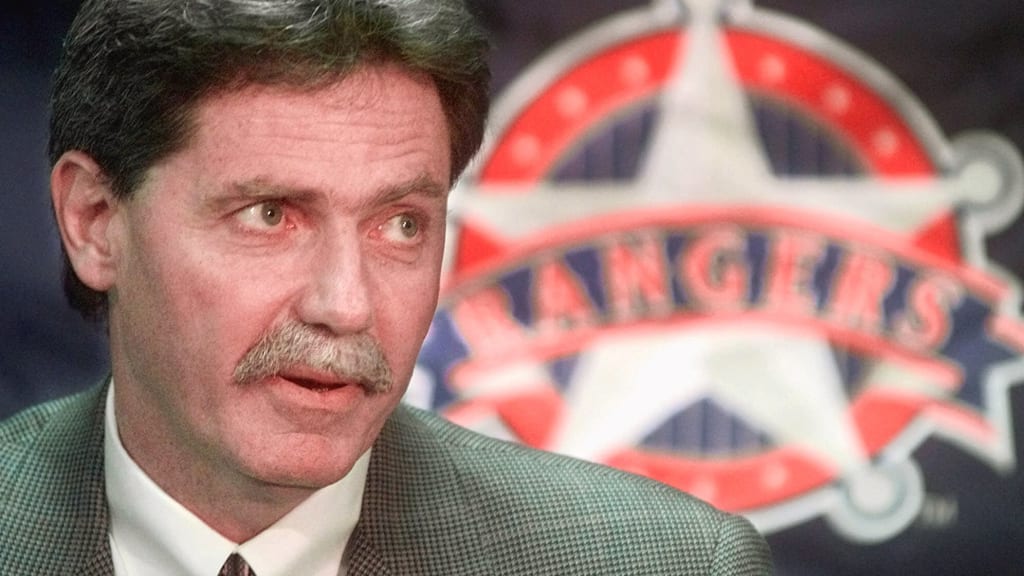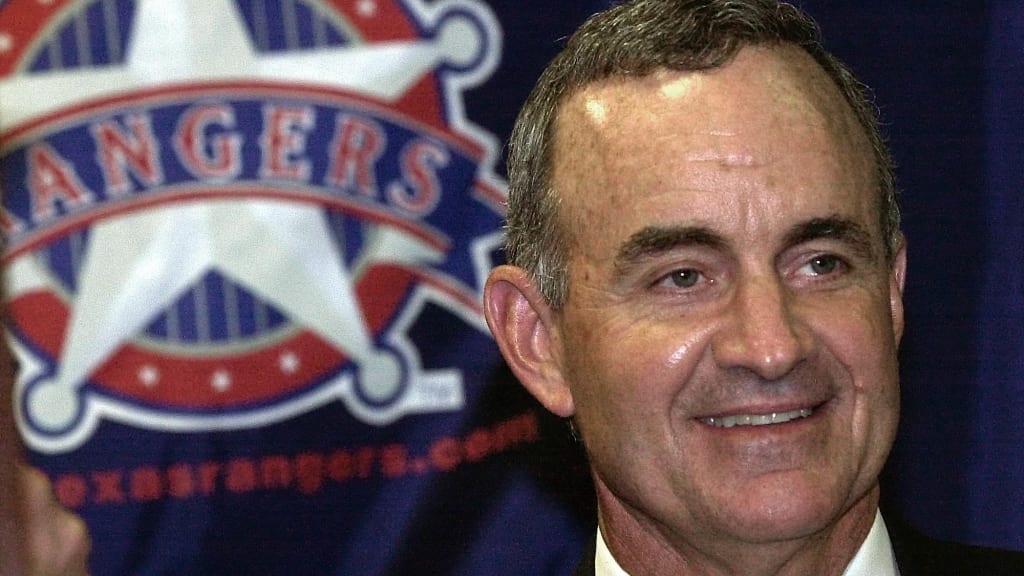
ARLINGTON -- No one loves a good debate quite like baseball fans, and with that in mind, we asked each of our beat reporters to rank the top five players by position in the history of their franchise, based on their career while playing for that club -- before grading the managers and, now, the general managers.
These rankings are for fun and debate purposes only … if you don’t agree with the order, participate in the Twitter poll to vote for your favorite.
Here is T.R. Sullivan’s ranking of the top 5 GMs in Rangers history.
1. Jon Daniels, 2005-present
Key fact: Built two pennant-winning teams in 2010-11, plus two more division champions in '15-16.
On May 20, 2012, the Rangers defeated the Astros, 6-1, giving them a five-game lead in the American League West. Texas was coming off two straight trips to the World Series and was loaded, appearing to be the best team in baseball.
Now, eight years later, that date can be circled as the high-water mark of the Daniels era.
Prior to that, Daniels had an impressive run of astute moves leading to two pennants. Mark Teixeira and Ron Mahay to the Braves for a package that included shortstop Elvis Andrus and pitchers Matt Harrison and Neftalí Feliz is the runaway winner for the best trade in Rangers history.
There were more. Josh Hamilton acquired for Edinson Volquez; Mike Napoli for Frank Francisco; David Murphy, Colby Lewis, Adrián Beltré, Nelson Cruz, Bengie Molina, Alexi Ogando and Yu Darvish. Daniels even convinced the Mariners to take pitcher Blake Beavan instead of Derek Holland in a trade for Cliff Lee.
There were obvious missteps, but Daniels and his staff did an amazing job over a short period of time to get the Rangers to the World Series.
So what happened on May 20 to reverse the tide?
The next day, the Fort Worth Star-Telegram revealed that Feliz -- who had been switched from reliever to starter -- had a torn ligament in his right elbow and would require surgery.
That began a series of devastating pitching injuries that clobbered a staff otherwise well-built for long-term success: Feliz, Lewis, Harrison, Holland, Darvish and Martín Pérez.
Losing all of that talent was obvious. Just as debilitating was draining the farm system in trades needed to plug holes with Matt Garza, Ryan Dempster, Cole Hamels and others.
Daniels & Co. still made many smart moves, and winning 95 games in 2016 -- second most in club history -- was a remarkable achievement. But that run of pitching injuries had a huge impact on the Daniels regime that reverberates to this day.

2. Doug Melvin, 1994-2001
Key fact: Named Baseball America Executive of the Year in 1996, when he put together the first division championship in club history.
Melvin was excellent at working a trade, maybe the best of any Rangers general manager. Everybody is going to remember getting Michael Young and Darwin Cubillan for Esteban Loaiza in 2000, but the Rangers don’t win in 1996 without acquiring pitcher John Burkett from the Marlins on Aug. 8 for Dempster and Rick Helling.
The funny thing is Melvin pulled off a big steal the following summer by re-acquiring Helling for reliever Ed Vosberg. Getting Aaron Sele from the Red Sox that winter was another one.
Melvin’s biggest day was on July 31, 1998, when he pulled off two trades at the Deadline, He acquired pitchers Todd Stottlemyre and shortstop Royce Clayton from the Cardinals for pitcher Darren Oliver, third baseman Fernando Tatis and outfielder Mark Little. He also picked up third baseman Todd Zeile for two Minor Leaguers. Those two trades helped put the Rangers over the top in 1998-99.
The 1996 season was a memorable one, but it also contributed to Melvin’s downfall. The Rangers had four of the top 53 picks in the Draft -- including two first-rounders and a compensation pick -- and they drafted four pitchers: R.A. Dickey, Sam Marsonek, Corey Lee and Derrick Cook. They were all busts.
That, plus drafting right-hander Jonathan Johnson seventh overall in 1995 and failing to sign third-round pick Barry Zito in '98, ended up haunting Melvin. When he was dismissed after the 2001 season, owner Tom Hicks cited the Rangers' lack of young pitching.
Hicks also never forgave Melvin for not being more aggressive in pursuing Roger Clemens, who was with the Blue Jays, in the spring of 1999. Instead, the Blue Jays traded Clemens to the Yankees.

3. Tom Grieve, 1984-94
Key fact: Rangers were named Baseball America’s Organization of the Year in 1989.
Grieve was working as one of the Rangers' television broadcasters in 1996. The night the Rangers won the division title, Grieve had to interview Melvin in the celebratory postgame clubhouse.
Melvin graciously acknowledged the work Grieve and his team did in acquiring much of the talent in that joyous clubhouse. The list included Juan Gonzalez, Ivan Rodriguez, Dean Palmer, Rusty Greer and others.
In 1989, when the Rangers were honored by Baseball America, they had nine people working on the baseball side of the front office. That included John Young, who was the Rangers' only professional scout. The club has 12 pro scouts right now.
But with Sandy Johnson as scouting director, Marty Scott running the farm system and Wayne Krivsky as assistant general manager, the Rangers drafted, signed or acquired an amazing amount of young talent while Grieve was in charge.
The Rangers just weren’t able to compete financially with the big boys and acquire the necessary complementary talent needed to fill out a championship roster. That didn’t really start to happen until the Ballpark in Arlington opened in 1994. By then, well, it was time for a change.

4. Eddie Robinson, 1976-82
Key fact: Purchased pitcher Charlie Hough from the Dodgers for $50,000.
Robinson had the résumé and image of a crusty, old-time baseball executive. But one of his hires had a profound impact on front offices throughout baseball.
Robinson hired Craig Wright, who was one of the pioneers in what then was known as sabermetrics. Wright was the first statistical analyst to work in a Major League front office. Now they have taken over the game.
Manager Don Zimmer did not like the brilliant young hire and blamed Wright for his dismissal.
5. John Hart, 2001-05
Key fact: The job of replacing Melvin as general manager came down to Hart and Dave Dombrowski.
Hart’s first Winter Meetings for the Rangers was December 2001, in Boston. While Hart was there, he repeatedly said the Rangers would not pursue free-agent pitcher Chan Ho Park.
One month later, Hicks introduced Park at a press conference and announced the Rangers had found their No. 1 starter.
Hart did an incredible job turning the horrible Indians into an AL powerhouse during the 1990s. It was his magnum opus as a baseball executive.
But his time with the Rangers was ill-fated from the start. First of all, Hicks forced the marriage of Hart and scouting director Grady Fuson. The two men liked and respected each other, but it proved to be an awkward arrangement, especially after manager Buck Showalter was added to the mix.
Secondly, the Rangers were paying shortstop Alex Rodriguez $22 million per season, and there were a lot of ill-advised moves made trying to assemble a competitive team around him. Hence Carl Everett, John Rocker, Hideki Irabu … the list is lengthy.
It’s easy for Rangers fans to bash Hart. He did not react well to early criticism and ended up alienating key members of the media.
The reality is the whole situation was not what Hart envisioned compared to the situation in Cleveland. But he did hire Daniels and put him in position to follow as the next general manager.

